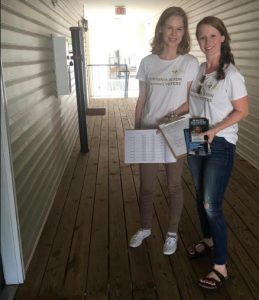 by Holly Hazard
by Holly Hazard
I answer the phone and wish I hadn’t as I’m immediately told how this is the most significant election in recent history and how important it is to canvass or phone bank early. Guilt, not passion or inspiration, drives me to agree, reluctantly, to spend a Saturday canvassing in an unfamiliar neighborhood. I bring my husband along, and, without much fanfare, we’re immediately separated. I’m handed a turf packet of about 80 names, some in an apartment complex that bans door-to-door solicitation. I’m told it’s important that I complete my entire packet. Four hours later, having had a few satisfying conversations, but mostly either finding no one home, or getting quick answers to the boxes I must check, I return my pack, retrieve my husband and, relieved, go home.
In my thirty years in the non-profit sector I’ve witnessed the evolution of volunteer management from one of exploitation of “free labor,” to one valuing volunteers as integral to our success and determined to provide an appropriate, significant, and personalized experience. Our conferences include tracks on volunteer management, research studies abound, and many non-profits have staff whose job is only to keep volunteers engaged and happy. Not so, it seems, with the Virginia Democrats and our coordinated campaign. It appears that the party hasn’t noticed all the energy and passion left with no place to engage because the only opportunity to help appears to be those dictated from a headquarters far away, and a model that hasn’t changed in at least 15 years.
Virginia Democrats have a limited volunteer pool that keeps coming because of the frightening commentary on CNN, not because of any significant, positive experience with our party. Many volunteers drop out after one or two tries, or never start to engage, because they’d “like to help but they don’t canvass.” The turf packs are too big, canvassing with a partner requires two packs and double the commitment, the script is often stilted and awkward, the tough canvas sites (apartments or HOAs that resist campaigners) aren’t pulled and given to an elite canvass team. Volunteers may be briefly trained by people who may need more training themselves, are sent to houses far from home, aren’t made a part of any community or tribe, or even thanked. And they aren’t offered other options that may better satisfy them, such as postcard campaigns or social media outreach that may be a portal to more activism.
A science exists to soliciting and retaining volunteers, which includes providing a rewarding experience, and excellent training and rewards. The value of our volunteers needs to be recognized, appropriately appreciated, and crafted to meet their needs, not just the needs of the campaign. The coordinated campaigns are short-term but the party and the volunteers are a permanent foundation of those campaigns. Building volunteer satisfaction should not be left solely in the hands of the entity with short-term goals. If this [and the next and the next] is the most important election of our lives, we need everyone to engage— not just those who fit into an arbitrary rubric, long since discarded by most social justice enterprises. We need to invest in a volunteer experience that works for the party and the candidates, but also for the largest cross-section of passionate progressives we can attract to help.
P.S. The cover photo is of canvassers (Alexandra Clayton and Elisabeth Holmes) in 2017 for House of Delegates Democratic candidate Wendy Gooditis.











![Saturday News: “Trump’s latest tariff TACO probably won’t make your life more affordable”; “The Epstein Email Cache: 2,300 Messages, Many of Which Mention Trump”; “[MTG] questions if Trump is still the ‘America First’ president”; “Jim Ryan tells all: ‘What did the Governor know, when did he know it?’”](https://bluevirginia.us/wp-content/uploads/2025/11/montage1115-100x75.jpg)

